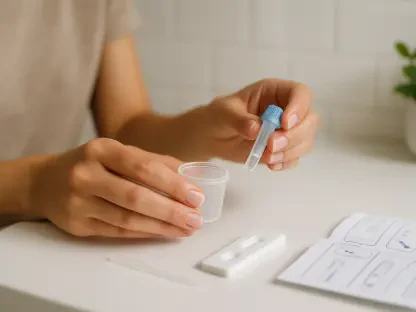The accuracy of pulse oximeters, devices commonly used to estimate blood oxygen levels, has come under scrutiny due to evidence suggesting performance discrepancies across different skin tones. This issue has prompted the US Food and Drug Administration (FDA) to propose new draft guidance aimed at improving the accuracy and performance of these devices, particularly for individuals with darker skin pigmentation.
Understanding Pulse Oximeter Discrepancies
The Role of Pulse Oximeters in Healthcare
Pulse oximeters are vital tools in medical assessments, providing critical information about a patient’s oxygen saturation levels. These devices are widely used in various healthcare settings, from hospitals to home care, making their accuracy paramount. By shining light through a patient’s fingertip, earlobe, or other tissue, the device measures the amount of light absorbed by the blood to estimate oxygen saturation. Accurate readings from pulse oximeters are essential in diagnosing and managing conditions such as chronic obstructive pulmonary disease (COPD), pneumonia, and COVID-19. Healthcare providers rely on these readings to make timely decisions that can significantly impact patient care. Therefore, any inaccuracy in these devices can lead to serious consequences, including misdiagnoses or delays in treatment.
Evidence of Inaccuracy
Recent studies have highlighted that pulse oximeters may not perform equally well across different skin tones. Specifically, individuals with darker skin pigmentation are more likely to receive inaccurate readings, which can lead to significant healthcare implications. For instance, a study published in the New England Journal of Medicine found that pulse oximeters were more likely to miss instances of low blood oxygen levels in Black patients compared to white patients. This discrepancy is believed to be caused by the way pulse oximeters measure light absorption. Melanin, the pigment responsible for skin color, can affect the absorption and reflection of light, leading to potential errors in the readings. These findings underscore the urgent need for improving the design and testing of pulse oximeters to ensure they provide accurate readings for all patients, regardless of skin tone.
Impact on Patient Care
Inaccurate pulse oximeter readings can result in misdiagnoses or delayed treatments, particularly for conditions where oxygen levels are crucial. This disparity underscores the need for more reliable and inclusive medical devices. For example, a patient with an undetected low oxygen level might not receive timely interventions such as supplemental oxygen or other critical care, potentially leading to worsened health outcomes. Additionally, inaccurate readings can contribute to disparities in healthcare quality. Patients with darker skin tones may face a higher risk of adverse outcomes due to the reliance on potentially faulty readings. Therefore, addressing these discrepancies is not only a matter of improving device accuracy but also a crucial step toward achieving equity in healthcare. Ensuring all patients receive precise and reliable diagnoses is fundamental to providing high-quality care.
FDA’s New Draft Guidance
Recommendations for Manufacturers
The FDA’s draft guidance includes comprehensive recommendations for pulse oximeter manufacturers. These guidelines emphasize the importance of including a diverse pool of study participants in clinical trials to ensure the devices’ accuracy across various skin tones. By incorporating participants with a wide range of skin colors and other demographic variables, manufacturers can better understand how their devices perform under different conditions. The guidelines also recommend employing standardized methods for evaluating and quantifying skin tones during device testing. This approach aims to eliminate subjective biases and create a more objective and consistent measure for assessing pulse oximeter performance. By focusing on inclusivity in clinical trials and standardized testing, the FDA seeks to improve the overall reliability and fairness of these essential medical devices.
Standardized Methods for Skin Tone Evaluation
To address the issue of skin tone discrepancies, the FDA recommends the use of standardized methods to evaluate and quantify skin tones. This approach aims to create a more objective and consistent measure for assessing device performance. For instance, the FDA suggests using the Fitzpatrick skin type classification system, which categorizes skin tones based on their response to ultraviolet light exposure, as a potential tool for standardization. Quantifying skin tones in a standardized manner allows for a more accurate assessment of how different pulse oximeters perform across various skin types. It also facilitates comparisons between different models and brands, helping healthcare providers make informed decisions about which devices to use. These efforts are designed to ensure that pulse oximeters provide accurate readings for all individuals, thereby enhancing the quality and equity of patient care.
Inclusive Data Collection
Manufacturers are encouraged to gather more inclusive clinical data through controlled laboratory studies and real-world data collection. This comprehensive data collection is essential for capturing the true accuracy of pulse oximeters across different skin pigmentations. By including participants from diverse backgrounds in clinical trials and real-world studies, manufacturers can obtain a more representative understanding of device performance. Collecting data from real-world settings, such as hospitals and clinics, can also provide valuable insights into how pulse oximeters function under various conditions. These data can help identify potential issues that may not be apparent in controlled laboratory environments. By prioritizing inclusive data collection, the FDA aims to ensure that pulse oximeters are tested comprehensively and fairly, ultimately leading to more reliable devices for all patients.
Ensuring Transparency and Expedited Review
Transparent Labeling
The FDA proposes that pulse oximeters meeting the updated accuracy standards should include clear labeling. This labeling will help users easily identify devices that have been proven effective across diverse skin tones, ensuring informed decision-making. Transparent labeling allows healthcare providers and patients to choose devices that are verified to deliver accurate readings for individuals with different skin pigments. Clear labeling also eliminates uncertainty and builds trust in the medical devices used. For instance, a label indicating compliance with updated accuracy standards can reassure healthcare professionals that they are using a device capable of providing reliable results for all patients. This transparency is crucial for promoting equity in healthcare and ensuring all patients receive appropriate care based on accurate data.
Expedited Device Review
To ensure the public gains access to accurate and reliable pulse oximeters promptly, the FDA plans to expedite the review process for devices that meet the updated performance criteria. The goal is to complete reviews within 30 days, facilitating quicker access to improved devices. Expedited reviews prioritize public health by ensuring that advancements in device technology are translated into clinical practice without unnecessary delays. By shortening the review timeline, the FDA hopes to encourage manufacturers to adopt the new standards quickly and bring updated devices to the market faster. This prompt integration of improved devices aims to address the existing discrepancies in pulse oximeter performance and enhance patient care across diverse populations. Additionally, it represents the FDA’s commitment to proactively improving healthcare equity.
Scope and Applicability of the Guidance
Focus on Medical-Grade Devices
The FDA’s guidance specifically targets medical-grade pulse oximeters used in clinical decision-making. It does not cover general wellness products or devices intended for non-medical purposes, such as sports or aviation. Medical-grade devices are subject to stricter regulatory standards and are critical in diagnosing and monitoring patients in clinical settings. General wellness products, often used for fitness tracking or personal monitoring, do not typically undergo the same rigorous testing and evaluation. As a result, the FDA’s guidance focuses on ensuring that the devices used in medical environments—where accurate oxygen saturation readings are crucial—meet the highest standards of accuracy and reliability. This focus aims to support the delivery of precise and trustworthy healthcare.
Current Device Standards
Some pulse oximeters currently available may already meet the enhanced standards proposed by the FDA. However, proper data collection and updated labeling are necessary to ensure these devices are recognized for their accuracy across different skin tones. Manufacturers will need to provide evidence that their devices have been tested against the new guidelines and perform accurately for diverse populations. Ensuring devices meet the updated standards involves both retrospective and prospective evaluations. Retrospective evaluations review existing data to determine if the current models meet the new accuracy criteria, while prospective evaluations involve additional testing. This dual approach ensures a comprehensive assessment of device performance and encourages continuous improvement in medical device standards.
Stakeholder and Public Feedback
Collaboration with Stakeholders
The FDA has actively sought feedback from various stakeholders, including scientists, healthcare providers, and manufacturers, to refine and ensure the effectiveness of the new guidelines. This collaborative approach aims to address the concerns and needs of all parties involved. Engaging stakeholders in the development process helps create guidelines that are practical, scientifically sound, and widely accepted. By involving a diverse group of experts and users, the FDA can better understand the challenges and opportunities associated with the proposed changes. Stakeholders provide valuable input on the feasibility of recommendations, potential barriers to implementation, and strategies for effective deployment. This inclusive approach ensures that the guidelines are well-rounded and take into account the perspectives of those who will use and benefit from the devices.
Public Presentation of Compliant Devices
To provide transparent and clear information, the FDA plans to present devices that meet the new standards on an accessible web platform. This initiative will help healthcare professionals and the general public make informed choices about the pulse oximeters they use. By listing compliant devices online, the FDA promotes transparency and facilitates easier identification of reliable products. The web platform will serve as a centralized resource, offering up-to-date information on the performance of various pulse oximeters. It will also include details on the testing protocols and methodologies used to evaluate the devices. This transparency not only helps users make informed decisions but also encourages manufacturers to adhere to the highest standards of accuracy and performance in their products.
Research Insights and Scientific Basis
Supporting Studies and Collaborations
The FDA’s recommendations are grounded in the latest scientific evidence, including controlled studies and real-world performance data. Collaborations with academic institutions and advisory committee meetings have been instrumental in developing methodologies to evaluate device performance considering skin pigmentation. These partnerships bring together a wide range of expertise and resources to address the complex issues surrounding pulse oximeter accuracy. Academic collaborations provide access to cutting-edge research and innovative testing methods, while advisory committees offer diverse perspectives and insights. Together, these efforts have led to the development of robust guidelines that are scientifically sound and practically applicable. By leveraging these collaborative efforts, the FDA aims to ensure that the new standards are both rigorous and achievable.
Objective Evaluation Methods
The agency emphasizes the importance of using both subjective and objective measures to quantify skin tone. This dual approach aims to create a more accurate and reliable assessment of pulse oximeter performance across diverse populations. Subjective measures may include visual assessments or participant self-reporting, while objective measures could involve using standardized tools or technologies to quantify skin pigmentation. Combining subjective and objective methods allows for a comprehensive evaluation of device performance, ensuring that all aspects of skin tone variability are considered. This thorough assessment is crucial for identifying potential biases and inaccuracies in pulse oximeter readings. By adopting a multifaceted approach, the FDA aims to enhance the reliability and equity of medical devices, ultimately leading to better patient outcomes.
Commitment to Healthcare Equity
Addressing Disparities in Medical Devices
The FDA’s initiative reflects a broader commitment to healthcare equity. By addressing the disparities in pulse oximeter performance, the agency aims to ensure that all segments of the population receive precise and reliable healthcare diagnostics. This effort is part of a larger movement to make medical devices more inclusive and fair, reducing healthcare disparities and improving outcomes for underserved populations. Addressing these disparities requires a concerted effort from all stakeholders, including manufacturers, regulators, healthcare providers, and patients. The FDA’s guidance is a crucial step in this direction, setting the stage for more equitable healthcare practices. By prioritizing accuracy and inclusivity in medical device development, the FDA is fostering a healthcare system that truly serves all individuals, regardless of their background or skin tone.
Industry and Public Cooperation
The reliability of pulse oximeters, which are widely used devices for measuring blood oxygen levels, has been questioned due to studies indicating that their accuracy may vary significantly across different skin tones. Research has shown that these devices can be less accurate for individuals with darker skin pigmentation, leading to potential health risks due to incorrect readings. This situation has raised significant concerns, prompting the US Food and Drug Administration (FDA) to take action. In response, the FDA has proposed new draft guidance aiming to enhance the performance and precision of pulse oximeters. The focus is particularly on ensuring these devices provide accurate readings for people with darker skin tones, addressing the disparities and improving overall patient care. The FDA’s proposed guidelines are intended to standardize pulse oximeter performance, reduce discrepancies, and ensure that all patients receive accurate and reliable measurements regardless of their skin color.









